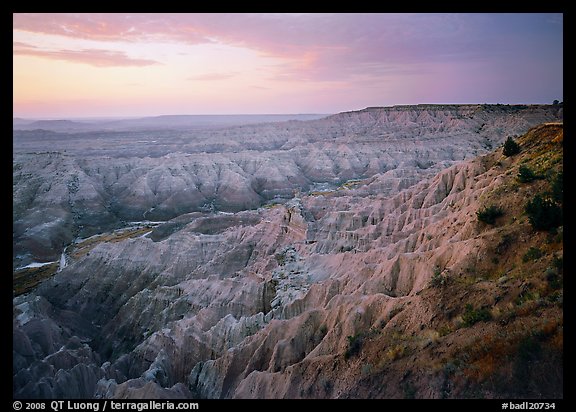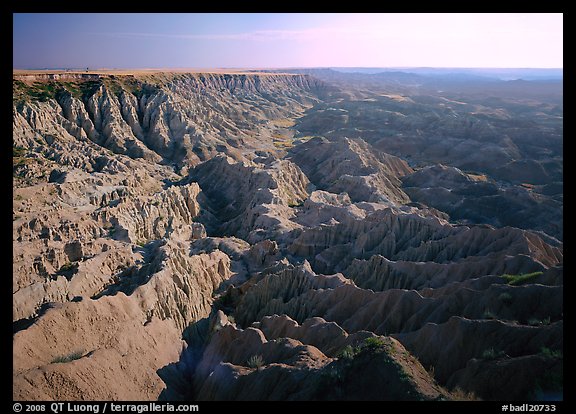Photo Spot 41: Badlands National Park – Red Shirt Table Overlook
3 Comments
Like in Theodore Roosevelt National Park that we visited two weeks ago, badlands dominate the landscape of Badlands National Park (surprise !).
However, there is a striking difference of scenery. While in Theodore Roosevelt National Park I saw the badlands mixed with shrubs, conifers, and aspens (which provide some color accents in autumn), in Badlands National Park, the vegetation consists only of stretches of prairie.
This absence of high vegetation made the Badlands landscape more stark, revealing the effects of erosion on a large scale. Standing on the overlooks reminded me of the landscapes of the Colorado Plateau where canyons and ridges seemed to stretch as far as the eye can see. The same forces of water were at play here, although on a shorter geological time scale, as the sediments and mud that makes up the Badlands is much softer.
Although many of the easily accessible overlooks in the park main North unit (including Pinnacles, right off the Wall entrance) provide excellent perspectives, I remember most the Stronghold Unit, as it provided a remarkable solitude – it is seen by only 1% of the visitors to Badlands National Park – extensive views, and a connection to Indian history.
The whole Black Hills of South Dakota rightfully belongs to the Lakota people. In 1851, the boundaries of Lakota land were clearly marked in the first Treaty of Fort Laramie. They were reaffirmed in the second Fort Laramie Treaty of 1868, after the Lakota defeated the US army several times, making it the only war in American history in which the US negotiated peace by conceding everything demanded. Yet the US found ways to get around the Treaty. The Indian Wars ended with in 1890 at the Wounded Knee massacre where 300 men, women, and children were indiscriminately shot using the new Hotchkiss gun, a rapid fire weapon that fired exploding shells. Today, their descendants are confined to the Pine Ridge Reservation, one of the poorest areas in the country, with rates of unemployment, illness, and mortality comparable to some of the most troubled third-world countries.
The South Units of Badlands National Park (Stronghold Unit, and the inaccessible Palmer Unit) are made up of lands that belong to the Pine Ridge Reservation, however, even those lands were appropriated by the US in 1942 for a gunnery and bombing range. Today those lands are still administered by the National Park service. There is currently a serious proposal to give back the National Park Service South Unit lands to the Oglala Sioux Tribe for management as America’s first tribal national park. However, a return of the Black Hills to the Lakota is very unlikely: the Supreme Court, even as it agreed in 1980 that the Black Hills were illegally taken, just offered a payment of $106 million as compensation, which was refused by the tribes.
State Road 40 follows the western boundary of the Stronghold Unit inside the Pine Ridge Reservation. I was looking for the Red Shirt Table Overlook, clearly marked on the map provided by the National Park Service, but not so easy to locate on the terrain in the pre-dawn dark. After a few hesitations, I left the main road and drove through an open gate to the overlook, a few hundred yards right to the edge of the plateau. There was nothing there except for a few portable toilets.
An immense basin, filled with innumerable spires stretched before me, filling up the whole eastern view. I could see in the distance the Stronghold Table, where the last Ghost Dance was performed. The darkness gradually gave way to a dim light. Since I would be shooting towards the East, I expected the best light to be in the quarter-hour at dawn starting half an hour before sunrise. The light is generally too flat at mid-day in the Badlands to shoot expansive landscapes. The flat horizon made it possible to use a strong graduated neutral density filter that preserved some of the subtle color in the sky while I exposed for badlands, which were illuminated by a dim, but directional light. After the sun rose, the contrast increased quickly. I tried another composition, then just sat there to enjoy the place and try to feel the native spirits. I did not see a single other soul until I departed.


View more images of Badlands National Park.


Beautiful images QT. You really captured the expanse and solitude of this area. I can imagine listening to Carlos Nakai while watching the sun rise.
Gorgeous Badlands imagery, one of my favorite places in the Continental US, for the same reasons you mention. Might want to check the typo on Red Shirt, however. The dropped “r” in Shirt distracts from the rich story.
Jeff Behm
Behm Photographics
Thanks Jeff for the correction. This was a particularly bad typo 🙂